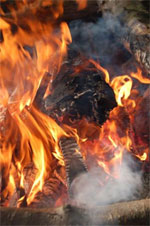
Firelighting
Preparation is vital…take plenty of time to prepare the fire and materials before you even think of lighting the fire.
Fuel should be graduated into piles from kindling through to main fuel and logs. Tinder should be dry and as fine as you can get it.
There should be ample fuel to keep the fire going for many hours before you light the first match.
Make sure you have the right materials, that are stored neatly and dryly to hand and that you know what type of fire and method of lighting you are going to use.
In principle it is easy, and I can explain little more than there is here. In practice it will take years of trying to perfect the technique. There simply is no substitute for practice. No amount of reading will help you any more. Go find someone who knows what they are doing and get out there and practice!

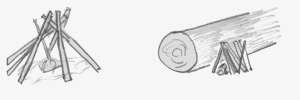 Technique
Technique
The most common way to begin a fire is to make a bed of tinder and then form a 'wigwam' of kindling around it, starting with the lowest grade. In theory (!) one match should light the tinder, and then the kindling will catch. You can then gradually and carefully add higher and higer grades of wood to build up the fire. For windy or light rainy days, lay a stack of kindling up against a log.
A slightly better way is to form bundle of sticks, no larger then a match, light these first and then place them in the kindling (see the fire stick below).
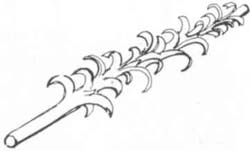 Firestick
Firestick
A fire stick is made by shaving a stick with shallow cuts to 'feather' it. This can be used as kindling and will catch light freely and quickly create a fire.
Matches
Matches are the easiest (but not the only) way to start a fire. I think that the non-saftey 'strike anywhere' matches are the better type. Always carry some to camp (and when hiking etc.). Keep them in a waterproof container (make sure they cannot rub against anything).
Damp matches can be a problem. If you have dry, non-greasy hair try rolling them in it (trust me, it does work! Static electricity will 'dry' the match). Try striking damp matches by stabbing at an angle onto the striker strip instead of pulling the match across it.
A sensible thing to do is whenever you strike a match, light a candle. You can then light many things from the candle, saving matches. The candle could even then be put into the middle of the kindling itself to start the fire.
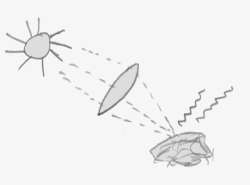 Using a Lens
Using a Lens
You can use a lens (not all lenses!) to focus strong sunlight to a point. Given enough direct sunlight it should produce enough heat to ignite the tinder. You may have to be patient. This is indeed how some accidental fires are caused by the sun shining through broken bottles and such like. A magnify glass is the best known example for this technique but a telescope or camera lens could be used as well.
Animal Fats
Animal fats (with a wick in the middle especially) can be used in suitable ventilation as a good fire, in particular when used as a stove in a tin can. In the polar regions, animal fat place on a support of bone is sometimes the only available fuel.
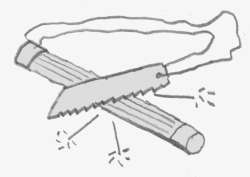 Flint and Steel
Flint and Steel
Often found in 'survival kits' the flint & steel can be a useful method, as it can be tried many times unlike the 'one-strike' match. Flint is actually found in many parts of the world (look at the top of chalk escarpments). When you strike the flint and steel together, with effort, sparks are produced which can ignite decent, dry tinder.
Most often they come as a 'kit' with a flint bloke, and a steel saw attached by a cord. Simply draw the saw across the block whilst holding it close to the tinder so that the sparks can fall on it.
Depending upon the quality of your tinder and the weather, you may have to be patient to get any fire going.
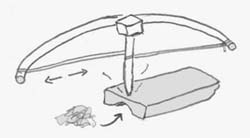 Fire Bow
Fire Bow
This is a friction method that requires a lot of practice but can be surprisingly useful. It consists of a hardwood spindle being rotated on a softwood base. This will first produce tinder, and then will ignite the tinder.
Useful woods are Balsa, pine, bamboo for the soft wood. Oak, ash and beech for the hard wood. They must all be perfectly dry.
Carve a small depression at one end of the base block and cut a cavity below it (in which you will put your tinder). Make an even, cylindrical spindle from the hardwood. You will also need to make yourself a bow from a pliable wood (hazel, bamboo with string made from bootlaces, hide or twine). You may also find it helpful to have a block of stone or wood on which you can push down the spindle.
First you wind the bowstring around the spindle. The place the spindle in the depression and push down upon it with your stone. With your other hand move the bow backwards and forwards. As the spindle spins you can increase the speed until it starts drilling through the wood. Just as it enters the cavity push down hard and go for it and 'bow' harder! With a little luck you will find the tip of the spindle will 'ignite' like a small coal and drop onto the tinder. If you tend the tinder carefully and blow on it you will be able to start a fire.
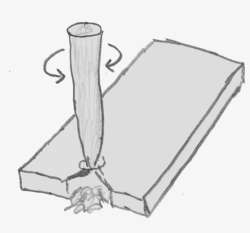 Hand Drill
Hand Drill
This is basically a variation on the fire bow method. You will need a hardwood base with a v-shaped notch, and a spindle of hollow soft wood.
Roll the spindle between your hands, running your hands down the spindle with each burst of spinning. When the friction makes the tip glow red, blow gently to ignite the tinder.
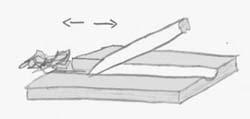 Fire Plough
Fire Plough
This is yet another friction method. Cut a small groove in a soft wood base and then 'plough' along the groove with the tip of a hardwood shaft, up and down the groove. This will produce fine shavings at first that will collect at the end, this is your tinder. Eventually the friction will ignite the tinder (with a lot of hard work!).
Chemicals
There are a few examples where common 'household' chemicals can be used to start a fire. As always care should be taken with all these types of methods. The most common way to use them is to grind them between rocks, or place them near the friction points for the above friction methods.
Details of Chemical Firelighting have been removed for reasons of safety.
Scouting Resources does not condone their use in scouting.
Battery Firelighting
A spark from a battery can start a fire, even torch and radio batteries have enough power to do this. Take two lengths of wire and connect them to the terminals. Slowly bring the bare ends of the two pieces together. Just before they touch a spark will be produced which you must catch on your tinder.
Soaking the tinder in a flammable liquid will help this along, although care should be taken.
